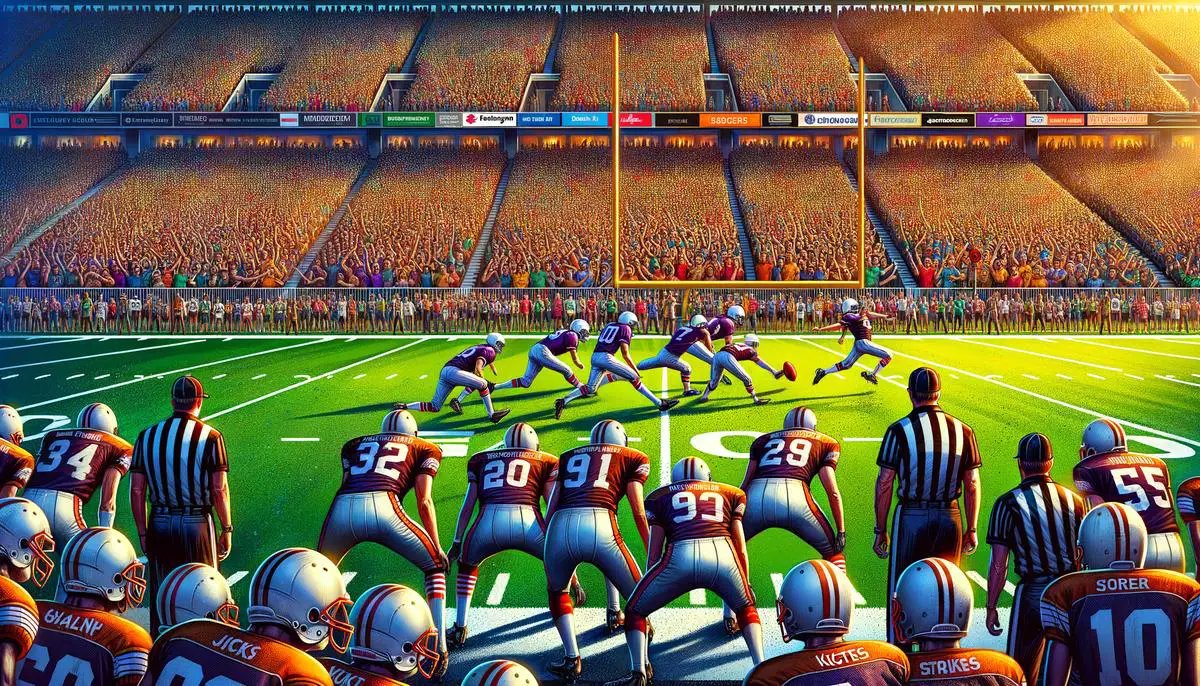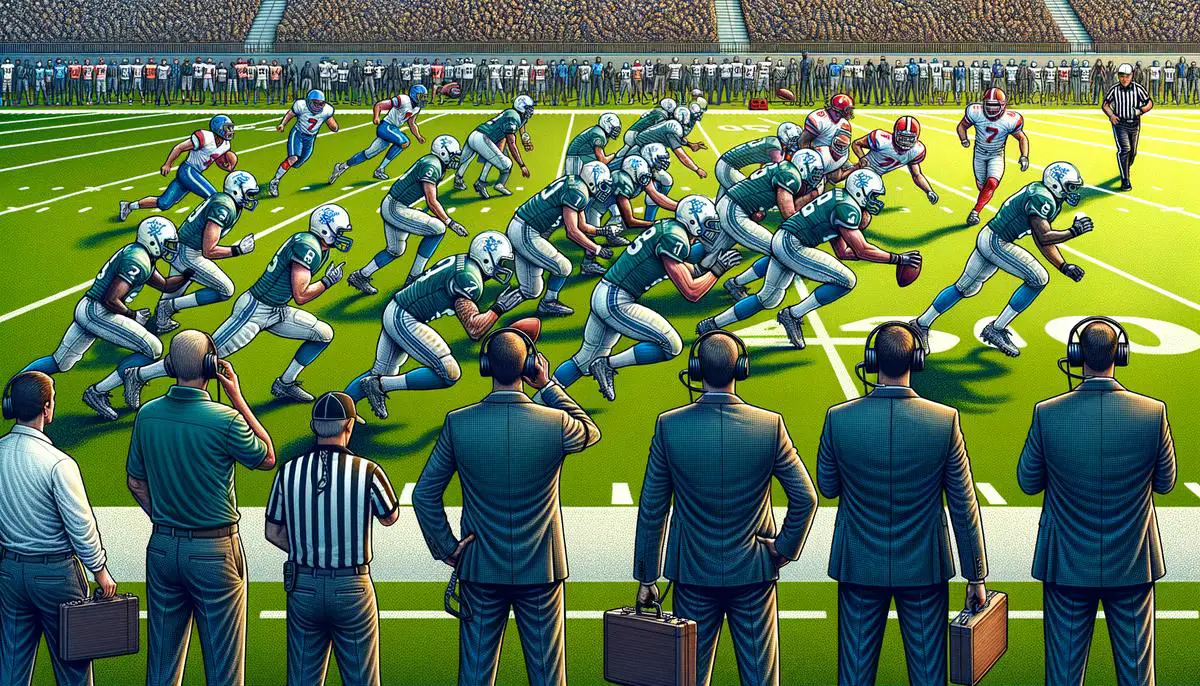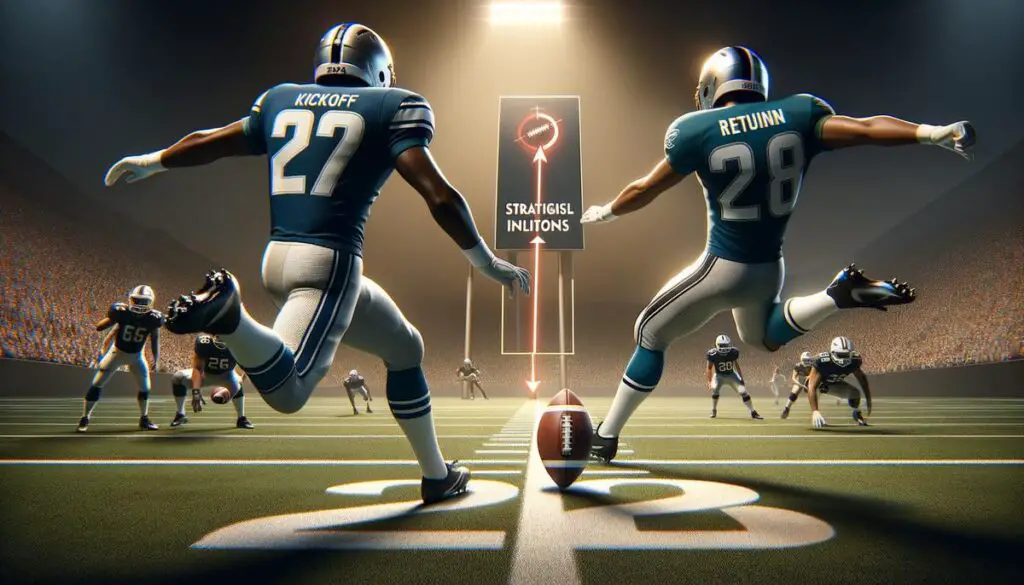Rule Overview
At the heart of the new strategy is the setup for kickoffs. The kicker places the ball at his team’s 35-yard line while his teammates line up at the opponent’s 40-yard line. This formation aims to reduce the risk of full-speed collisions, prioritizing player safety.
The return team responds by positioning most of their players in the “set-up zone,” between their 35- and 30-yard lines, directly in front of their opponents. The objective is to create a barrier that hinders easy penetration by the kicking team.
Fact Check
Claim: NFL modifies kickoff rules to improve player safety
Description: The NFL has introduced a series of changes in its kickoff rules with the primary objective of minimizing player injuries without compromising on the excitement of the game. The revised rules involve new formations to reduce the risk of full-speed collisions, changes in the position of the ball for a touchback, and modifications to onside kicks.
The “landing zone,” the area between the goal line and the 20-yard line, is where the ball is expected to land. This zone is pivotal, with strategy unfolding based on the ball’s landing spot.
If the ball flies over everyone’s head for a touchback, it will be placed at the 30-yard line instead of the 25-yard line. This change encourages teams to attempt returns rather than settling for touchbacks.
Onside kicks have also been modified. Teams can only attempt an onside kick in the fourth quarter and must declare it beforehand. It’s a crucial moment that could impact the game’s outcome.
If strong winds knock the ball off the tee twice, kickers are permitted to use a kicking stick, a tripod that provides stability.
Under these new rules, each kickoff involves precision, tactics, and power. The NFL strives to maintain excitement while prioritizing player welfare.
The 2024 season promises kickoff routines that differ from the past, with games featuring kickoffs that are more than just formalities. As fans, we can appreciate the NFL’s efforts to evolve the game while keeping players safe.

Safety Objectives
The NFL’s new kickoff rules, while appearing complex initially, are thoughtfully designed to prioritize player safety. The evolution of these rules addresses the need to maintain the excitement of football without compromising player well-being.
The new placement of kickoff teams at the receiving team’s 40-yard line reduces the distance for high-speed collisions. This arrangement alters the kickoff by minimizing the impact of those dangerous impacts that have caused injuries in the past. It’s a step in the right direction, showing the NFL’s commitment to protecting its players.
The “landing zone” serves as a designated area for focused play. By specifying where the ball should ideally land and focusing play within this zone, it directs the action into predictable patterns. This approach not only emphasizes strategic movements but also helps avoid unplanned collisions that could lead to injuries. It’s a way to balance the excitement of the game with the safety of the athletes.
The requirement for explicit declaration of onside kicks shifts the play from an unpredictable gamble into a battle of anticipation. When both teams know what to expect, there’s a reduction in unforeseen collisions. This change demonstrates the NFL’s proactive approach to player welfare.
Allowing the use of a kicking stick to combat strong winds introduces predictability into what was once left to chance. Reducing re-kicks minimizes repeated strain and exposure to collision opportunities, incorporating safety into the mechanics of kickoff execution. It’s a small but significant detail that showcases the NFL’s attention to player well-being.
The NFL’s Competition Committee crafted these rules to balance the risks and benefits of the game. Using data to guide discussions around player concussions and injuries, the committee aims to revise the playbook to reduce undue harm. It’s an effort to adapt the sport to the changing times and priorities.
The balance between exciting uncertainty and carefully designed safety measures reflects a sport evolving thoughtfully. The NFL acknowledges that the electrifying returns of the past can be revived, but their revival must not bring back the dangers that accompanied them. The strategic spread of on-field positions reflects a calculated approach, a compromise between the excitement of football and the importance of player safety.
By transforming the kickoff, the NFL demonstrates its commitment to safeguarding its players, ensuring that every touchdown and return contributes not just to the game’s history but also to a safer future for the sport. As fans, we can appreciate the NFL’s efforts to protect the athletes we admire and cheer for every week.
Impact on Game Strategy
The NFL’s revised kickoff playbook not only changes the dynamics on the field but also prompts a reevaluation of team strategies. This shift towards a safer yet exciting kickoff landscape opens up new possibilities for team compositions, talent scouting, and fourth-quarter tactics. Let’s explore how these rule revisions impact team strategy.
With potential returns becoming more valuable, the role of kickoff returners gains significance. Teams may seek out quick and agile players who can navigate through tight spaces and make the most of the “landing zone.” The era of frequent touchbacks gives way to a time where skilled returners can impact the game on any given play. It’s an exciting prospect for fans and teams alike.
Similarly, the importance of blockers evolves. The setup zone becomes a strategic standoff, requiring players who can quickly read formations and adapt their approach. Blockers who can effectively switch between power and finesse based on the needs of each kickoff will be highly valued. It’s a skill set that teams will actively seek out and cultivate.
The requirement for declaring onside kicks changes the strategic landscape of fourth quarters. Teams may develop specialized units to execute this high-stakes maneuver under intense scrutiny. Preparation for onside kick scenarios will become as crucial as any offensive playbook, with teams devising plays that balance predictability and creativity. It adds a new layer of intrigue to the game’s final moments.
Eliminating surprise onside kicks encourages teams to focus on overall resilience rather than risky gambits. The strategic emphasis shifts towards consistent, solid play, where foresight, preparation, and execution in known scenarios take precedence over impulsive decisions. Fourth quarters may offer fewer presumptive certainties for trailing teams, demanding meticulous planning and steady execution. It’s a challenge that will test the skills of coaches and players alike.
The NFL’s revised kickoff rules present a mix of order and spontaneity. Each kickoff becomes a complex story, with chapters unfolding customized strategies shaped by these new rules.
As coaches and players adapt to this modified game, mastery lies not in rigid power plays but in flexible adaptation and creativity. The 2024 kickoff ceremonies promise a showcase of strategic ingenuity, with each special teams sequence becoming a calculated move in football’s strategic array.1 It’s an exciting time for the sport, and we look forward to seeing how teams rise to the challenge.

Player and Coach Reactions
The Cohort’s Pulse: Players’ Revelations and Reverberations
From the linemen in the trenches to the speedy receivers awaiting the ball’s arrival, players across positions have voiced their opinions on this new rule change. Fast players resonate with the potential for increased returns, seeing the “landing zone” as an opportunity. However, there are also concerns, mainly from traditionalists, worried that this change may alter football’s core principles in the name of safety.
The special teams units have mixed reactions. The changes invite new strategies and innovation for some. Others express concern over the predictability set forth by mandating intentions on onside attempts, foreseeing a reduction in the game’s suspense.
Orchestrators and Sages: Coaches’ Contemplations
NFL coaches hold varied stances on the new rules. Some are cautiously optimistic, motivated by the new strategic possibilities the rules present. Tactics and formations are being reconsidered, such as using dual returners or creating tight-knit setup zone defenses.
Yet, there are also worries that over-engineered play may stifle football’s natural flow. Undeterred, coaches are preparing their teams for kickoffs’ new era, crafting drills and scenarios to adapt to this reinvented aspect of the game.
The Vault Keepers: Team Owners’ Assessments
Among team owners, a trio of dissent marked the ballot, even as approval prevailed. Those championing tradition had weighty reservations. Reluctance to experiment with this time-honored facet of play raised questions about whether tradition serves as an anchor or shackle in football’s march forward. However, at the core, there is a desire to minimize the game’s risks while emphasizing its competitive essence.
Migration to Practice Grids: Preseason Preparations Unfurled
Under the summer sun, teams are transforming these rule changes into tangible strategies. Special teams units analyze every aspect of these new tactics. Players practice orchestrated simulations of the updated kickoffs, blending athleticism with refined skill dictated by strategy.
Playbooks evolve as coaches tinker with strategy, bolstering their arsenals for the spectacle ahead.
From dawn to dusk, the league is engaged in spirited dialogue over progress and tradition. Every kickoff casts light on what forms triumph—be it adorned in advancement’s gleam or tradition’s sturdy foundation.

Comparison to Other Leagues
Rules Across Realms: A Comparative Odyssey of the Kickoff Conclave
The NFL’s decision to adopt elements of the XFL’s approach is noteworthy—a leap from speculation to actionable change. The XFL showcased scenarios where kickoff and return units engage at the opponent’s 35-yard line, as opposed to the NFL’s placement at the 40. Such boundaries prevent full-speed collisions across the field—an approach the NFL has echoed in its new rules.
Where the leagues diverge is within the realm of touchbacks. The XFL moves touchbacks to the 15-yard line, a contrast to the NFL’s 30-yard mark1.
Other leagues uphold traditional regulations, reinforcing routines rather than embracing change. The NFL’s stride represents both progress and homage; a new direction that also learns from other leagues’ experiences.
Essence in Singularity: The NFL’s Narrative Unfold
The NFL’s approach unfolds in a distinct way, with a structured set of rules that eliminate the element of surprise on onside kicks, generating new dynamics for special teams.
The new rules also prevent certain kickoff tactics, aiming to balance strategy and safety. The NFL is carving its own path, distinct from other leagues.
NFL vs. The Legion: On Fields Anachronistic and Vanguard
Comparing across leagues, it becomes clear that the NFL’s 2024 changes are multidimensional. Where some leagues might cling to tradition or make unrefined changes, the NFL is seeking a middle ground between excitement and safety.
The NFL’s approach journeys forward, distinct from other leagues. It seeks to learn from past contexts while forging its own path into the future.
These rule changes are expected to have a significant impact on the NFL. It’s a story of adaptation and anticipation, where every kickoff promises a fresh chapter of strategy and excitement. As we approach the 2024 season, it’s clear that these adjustments are not mere tweaks but a substantial step into a future where safety and spectacle are balanced.
While the journey ahead may have challenges, the NFL’s commitment to player well-being and the evolution of the game shines through these measures. As all stakeholders navigate this new territory, a spirit of unity and love for the sport will guide them.
The NFL’s move to redefine the kickoff game demonstrates its dedication to progress and its belief in the power of the sport to bring people together. As this new era begins, the stage is set for an exciting spectacle that will captivate audiences and create memorable moments.

